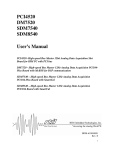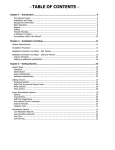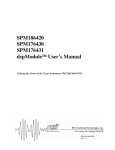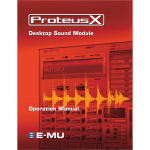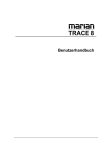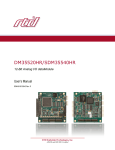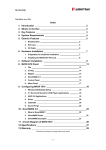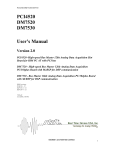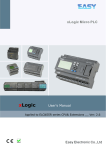Download Marc 8 MIDI
Transcript
marian MARC 8 MIDI User's Guide © November 2001, Marian. Hardware Design by Marian "SyncBus” developed by Marian All rights reserved. No part of this User's Guide may be reproduced or transmitted in any form or by any means, electronically or mechanical, including photocopy, translation, recording, or any information storage and retrieval system, without permission in writing from Marian GbR. All trademarks are the property of the respective owners. Marian is not liable for any damage to the software, hardware and data and costs resulting from it, which are caused by improper handling or installation of the hardware. The MARC 8 MIDI complies to the CE guide lines. 2 Table of Contents 1. Scope of Supply 2 2. System Requirements 2 3. Ports 3 3.1 3.2 3.3 MIDI Ports Audio Ports SyncBus Port 3 3 3 4. Hardware Installation 4 5. Driver Installation 4 5.1 5.2 5.3 5.4 5.5 5.6 MME, ASIO, DirectX and GSIF Windows 95 (Release 950 and 95a) Windows 95 (Release 95b and 95c) Windows 98 Windows NT 4.0 Windows 2000 4 4 5 5 6 6 6. MARC 8 MIDI Manager 7 6.1 6.2 6.3 6.3.1 6.3.2 Analog Inputs Analog Outputs Settings Tab "Audio" Tab "MIDI" 7. ASIO Settings 16 8. Technical Data 17 9. Service and Support 17 8 9 11 11 14 Dear User, thank you very much for your decision to purchase one of our products from the MARC product series. We wish you lots of success in working with our product. Please consider taking 15 minutes to study this guide. Besides traditional installation and operation instructions it contains information/hints that will make the handling with the MARC 8 MIDI easier for you. Your MARC 8 MIDI provides some special characteristics. In the following you will get a short overview of them: - Support of 24 bit and 96 kHz - Two MIDI interfaces - Integrated SyncBus - Multiclient drivers for Windows supporting ASIO,GSIF and MME - Multiple card support (you may plug up to 4 cards) - Flexible, latency free monitoring - 2 ms Latency to be achieved by using ASIO compliant applications 1. Scope of Supply First of all, please check, whether you received the following components undamaged and complete. - MARC 8 MIDI PCI card - Audio break out cable - MIDI break-out cable - User’s Manual - CD-ROM incl. drivers 2. System Requirements In order to be able to operate the MARC 8 MIDI, your PC should meet the following requirements: - AT compatible PC with a spare PCI slot - Pentium or AMD processor - Windows 95/98/ME, Windows NT4 SP3 or Windows 2000 Please note, that your used audio software may ask for different requirements. 2 3. 3.1 Ports MIDI Ports First of all plug the supplied break-out cable into the MIDI port (9-pin D-Sub connector). Using the 5-pin DIN connectors you can connect as many devices as you like with the MIDI port. 3.2 Audio Ports For using the audio ports of the MARC 8 MIDI first plug the supplied audio break-out cable into audio port (44-pin D-Sub connector). This breakout cable delivers 16 RCA jacks for the connection to your audio equipment. The input and output signals have line level. 3.3 SyncBus Port The figure on the right shows the board of your MARC 8 MIDI with the SyncBus port. You can see it as an 8-pin plug. If you use several MARC cards or other Marian cards, you connect the SyncBus ports of the individual cards using a cable which is available as accessory. You can purchase a SyncBus cable from your local dealer. The SyncBus of your MARC 8 MIDI has two jobs: on one side it synchronizes the clock, which is responsible for the record and play sample rate, and ensures that several cards run synchronously when they are operated parallel. On the other side it takes care of the concurrent and sample-accurate starting and stopping of several audio devices. It doesn’t matter whether or not these audio devices are located on the same card or on different cards. For details on the settings see chapter 6.3.1.1. 3 4. Hardware Installation Following the described steps below you can install up to four cards of the MARC 8 MIDI on the same PC. 1. 2. 3. 4. 5. 6. 7. Turn off your PC and all devices connected to it, disconnect the power supply. Open the case. Remove all cards from the anti-static foil. Make sure to hold the MARC 8 MIDI only at its edges or the slot bracket. Do not touch the components of the cards. Insert the card carefully and rectangular into a spare PCI slot. Ensure that the card was inserted properly into the slot. Screw the card on the slot bracket to the case. If you use the SyncBus for multi-card operation, please note Chapter 3.3 before closing the case. Close the PC case and reconnect it to the power supply. 5. Driver Installation 5.1 MME, ASIO, DirectX and GSIF For connecting software and hardware you can use the driver interfaces MME, DirectX or DirectSound, GSIF and ASIO. The driver for Windows 2000 today supports MME and ASIO – the driver for Windows NT4 MME only. The Windows 95/98/ME driver supports all these interfaces. This way you can use the MARC 8 MIDI with all common audio applications. If you use an ASIO compatible audio software, you will achieve extremely higher performance of the system as well as shorter latency periods. In an ideal case 2 ms are possible! 5.2 Windows 95 (Release 950 and 95a) 1. 2. 3. 4. 5. 6. 7. 4 Start your PC after installing your hardware. Windows automatically recognizes at startup the newly installed device and starts the Hardware Wizard. The "A new hardware component was found" window appears. When selecting the driver which is to be installed, please select the option “Driver from disk provided by hardware manufacturer” and confirm your selection. Insert the supplied CD in your CD-ROM drive. Select your CD-ROM drive using the "Browse" button, change to \marian\drivers\marc8m\win9x\english directory and confirm your selection. Windows copies the driver files and installs MARC 8 MIDI. After finishing the installation, your MARC 8 MIDI is ready to be operated without having to restart the system. 5.3 Windows 95 (Release 95b and 95c) 1. 2. 3. 4. 5. 6. 7. 5.4 Start your PC after installing your hardware. Windows automatically recognizes at startup the newly installed device and starts the Hardware Wizard. The "Wizard for device driver updates" appears. Insert the supplied CD in your CD-ROM drive and click "Next". Windows now searches for the updated drivers, but it cannot find any. Click "Other position" and click "Browse" in the opening window. Change into the \marian\drivers\marc8m\win9x\english directory on the CD and confirm it by clicking the "OK" button. Windows copies the driver files and installs the MARC 8 MIDI. During this process you are asked again for the driver's directory. Select the directory as described previously in step 5. After finishing the installation, your MARC 8 MIDI is ready to be operated without having to restart the system. Windows 98 1. 2. 3. 4. 5. 6. 7. 8. Start your PC after installing your hardware. Windows automatically recognizes at startup the newly installed device and starts the Hardware Wizard. During the start of Windows the Hardware Wizard searches for new drivers. Click "Next" to start the search. Enable the “Search for the best driver for your device” option and confirm by clicking "Next". Insert the supplied CD in your CD-ROM drive. Select your CD-ROM drive in the next dialog, change into the \marian\drivers\marc8m\win9x\english directory and then click "Next". The Hardware Wizard searches the CD-ROM for the appropriate drivers and finally displays the names of the drivers. Click "Next”; Windows copies the driver files and installs the MARC 8 MIDI. After finishing the installation click "Finish”. The driver will be enabled and the MARC 8 MIDI is ready to be operated without having to restart the system. 5 5.5 Windows NT 4.0 1. 2. 3. 4. 5. 6. 7. 8. 9. 5.6 Windows 2000 1. 2. 3. 4. 5. 6. 7. 8. 9. 10. 11. 6 Start your PC after installing your hardware. Log in using administrator rights. Open "System Control" and choose "Multimedia", then change to the "Devices" tab. Click "Add" button and confirm the opening window by clicking "OK". Insert the supplied CD in your CD-ROM drive. The "Install driver" window opens. Click "Browse", select your CDROM drive and on the CD-ROM select the \marian\drivers\marc8m\nt4\english directory. Confirm your selection by clicking "OK". Windows shows the recognized drivers in the “Unlisted or Updated Driver” window. Confirm the window by clicking "OK". The driver files are then copied. Then the MARC 8 MIDI is available without having to restart the system. Start your PC after installing your hardware. Log in using administrator rights. Windows automatically recognizes at startup the newly installed device and starts the Hardware Wizard. During the start of Windows the Hardware Wizard searches for new drivers. Click "Next" to start the search. Enable the “Install hardware driver” option and confirm by clicking "Next". Insert the supplied CD in your CD-ROM drive. Confirm the dialog “Search for drivers files” by clicking “Next” The Hardware Wizard searches the CD-ROM for the appropriate drivers and finally displays the names of the drivers. Click "Next”; Windows copies the driver files and installs the MARC 8 MIDI. Confirm the information about a missing software signature with “Yes” After finishing the installation click "Finish”. The driver will be enabled and the MARC 8 MIDI is ready to be operated without having to restart the system. 6. MARC 8 MIDI Manager After successful installation of the driver the shown symbol appears in the Windows taskbar for the MARCManager. You open the MARC-Manager by doubleclicking the taskbar symbol. The dialog box with checkboxes on the right is then displayed. By enabling the checkboxes "Analog Inputs", "Analog Outputs" and "Settings" further windows are opened, in which you can read and change the appropriate settings. In the "Analog Inputs" and "Analog Outputs" windows you have two possibilities to change the section view and hide or unhide the sections the way you want. You can either use the lowest section with the checkboxes "Monitoring", "PunchIn Mon.", "Level" and "Fader", or you right-click the title bar of the window and enable or disable the hooks in front of the section titles as shown on the right. 7 6.1 Analog Inputs The settings window for the analog inputs is divided from the top to the bottom into the sections Peak Meters and Gain Faders. In the Peak Meters you can see the level of the signals present at the input. Using the Gain Faders you can adjust the input level. The "M" button below the gain fader is a mute button. It turns off the audio signal on the appropriate channel. The checkbox in the middle below the mute button groups the gain faders of the single channels to stereo groups. 8 6.2 Analog Outputs The settings window for the analog outputs is divided from the top to the bottom into the sections Monitoring, Peak Meters and Volume Faders. In the Monitoring section you determine, which input signal should be switched to the appropriate output by using the upper buttons "In 1-2""In 7-8". The "OnRec" and "OnPunch" buttons determine when the chosen input signal should be switched to the appropriate output: during recording (“OnRec”), during a Puch In/Punch Out Recording (“OnPunch”) or immediately. 9 The Immediate Monitoring, which is shown on the right, is always enabled, as long as "On Recording" and "On Punch" are not used. The input signal is switched to the output – no other output signal can be heard. "OnRec" – which is also shown on the right - means, that the chosen input signal is switched to the appropriate output only during recording. This way you can check the recorded signal. "OnPunch" (figure on the right) means, that the input signal is switched to the output during the period of a Punch Recording. For this the audio software needs to provide the PunchIn or PunchOut command for the driver. In the peak meters you can see the signal levels at the output ranging from –60 to 0 dB. You can use the volume faders for adjusting the level. The peak meters does not change when the volume faders are changed, because it only displays the level pre fader, which is sent from the audio software or the input. The "M" button below the volume faders is the Mute button. It turns off the audio signal on the appropriate channel. 10 6.3 Settings In this window you can perform general settings for the driver of the MARC 8 MIDI. 6.3.1 Tab "Audio" 6.3.1.1 Section "Synchronization" "Mode" With the help of these options you determine, how MARC 8 MIDI deals with the SyncBus port and its signals. All settings performed here are not of any importance to any external synchronization between the MARC card and for instance sequencers, samplers, etc. 11 "Master" means that the card provides the synchronization signals for the SyncBus and synchronizes other cards. "Slave" means that the card evaluates the synchronization signals at the SyncBus and reacts on them. "Autonomous" means that the card does not provide and evaluate any signals at the SyncBus – the card runs in single operation. This setting is useful for instance if several audio applications have to use certain hardware. If several cards are to be synchronized using the SyncBus, then exactly one card has to be configured as Master; the other cards have to be configured as Slave. "Start/Stop Synchronization" In this field you determine, whether the synchronization applies to the recording or playing device or to both types. 6.3.1.2 Section "DirectSound" In this section you determine the settings for applications, which use DirectSound as driver interface. Here are some information in advance: the ideal settings for the DirectSound usage depend on some factors in your PC. Because of this we cannot recommend any ideal settings, but can only provide you some information on what's behind the possibilities for the settings. You will have to test yourself, what settings will suit best. Anyway, using the standard settings will ensure a trouble-free operation. ”Adjust Latency Manually” Moving the time control changes the size of the audio buffer on the card. If the settings for the latency period is too low, it may result in interruptions. In this case you will have to increase the latency period. "Restrict playback format to:" When using certain audio programs with DirectSound it may happen, that the DirectX system attempts to open the driver using a different sample format, than the audio programs intends to use. This results in a real time conversion of the signal format by the DirectX system. This conversion may have negative influence on the sound and system performance. If a playback using DirectSound does not sound correct, you will have to set the signal format, which you use in the audio software. This way 12 the DirectX system is forced to exclusively open the driver using the set format in the MARC Manager and the real time conversion is inapplicable. ”Available Playback Devices limited to:” Here you adjust the (stereo) output for DirectSound applications, which have no selection of the output. The output of the audio signals is then restricted to this (stereo) output. 6.3.1.3 Section “GigaSampler” We cannot inform you about the ideal settings for GSIF but will explain to you, what the terms stand for. In order to find the most suitable settings you will have to test. “Granularity” and “Latency” The granularity specifies the size of the audio data blocks, which are transferred to the hardware by the GigaSampler. The smaller the latency was set, the smaller will have to be the data blocks, in order to avoid interruption during playback (granularity: “Fine”). Though the system is more stressed because of the larger data overhead during the transfer, the reaction time for the sampler playback is shorter. Larger data blocks (granularity: “Coarse”) stress the system less, but the reaction time is longer and easier leads to interruptions during playback. For ideal results try to set the values of the two faders as low as possible. 6.3.1.4 Section "Common" ”Deactivate Error Messages caused by Clock or Samplerate Conflicts” Here we provide you the possibility to suppress all error messages in regard to clock and sample rate problems. Please note, that suppressing these error messages makes it more difficult for you to investigate an appropriate problem. 13 6.3.2 Tab "MIDI" In this tab you can edit and especially filter all MIDI commands processed by the MARC 8 MIDI. OI "Device" Here you can select the MIDI input or MIDI output for the command, which you wish to change. "MIDI stream optimization active" When enabling this option, you filter all unnecessary information from the transmitted MIDI commands. This way you achieve shorter processing times. 14 6.3.2.1 Section "Command Filters" In the Command Filter section channel related commands are processed. There are three view modes available: "View by command", "View by channel" and "View by matrix". The related level for the "View by command" are the individual MIDI commands. This gives you the possibility to filter or transmit a command on the individual MIDI channels. Using the On” and Off” buttons you can filter or transmit the command. Please note, that enabling a checkbox means setting the appropriate filter, i.e. the non-transmission of the MIDI command. The related level of the "View by channel" are the individual MIDI channels and provides for the selected channel the filtering or transmission of the individual commands. 15 The "View by matrix" shows all settings in an overview. The columns show the 16 MIDI channels and the rows show the MIDI commands. 6.3.2.2 Section "System Data Filters" In this section you can filter the channel independent MIDI commands like system commands. All performed settings also apply for the selected MIDI device. 7. ASIO Settings In the device setup you can see the window shown on the right. By enabling the checkboxes in front of the entries of the inputs and outputs you determine, which devices he ASIO application can 'see' and use. You can change the listed "Name (Alias)" in the first column by doubleclicking the entry. This way you can rename it as you like. The slider "Execution priority" determines in "high" position, that the transmission of ASIO data is given a higher processor priority, in the position "low" it is given the real time calculation of PlugIns. Should you use an ASIO compatible audio software, you may have to perform separate settings in the ASIO configuration of the software. For details please refer to the software manual. 16 8. Technical Data - 8analog inputs (RCA jacks via break-out cable) - 8 analog outputs (RCA jacks via break-out cable) - 2 MIDI inputs (5-pin DIN using break-out cable) - 2 MIDI outputs (5-pin DIN using break-out cable) - Sample resolutions [bit]: 8; 16; 20; 24; 32 - Sample rates: 11 kHz to 96 kHz (+/- 10% pitch) - Frequency Response @ 44.1 kHz: 20 Hz to 20 kHz - Frequency Response @ 96 kHz: 20 Hz to 40 kHz - Maximum input level: +8 dBu - Signal-to-noise ratio S (N+D) AD: 104 dB(A) - Signal-to-noise ratio S (N+D) DA: 114 dB(A) - THD: 0.005% 9. Service and Support Should you have any questions or problems during the installation or operation of your MARC 8 MIDI please perform the following steps: 1. Ensure that you always have the latest driver installed. You find the current driver files on the following internet page: http://www.marian.de/english/downloads.htm 2. Have a look in our Audio Guide, which has been published on the internet, whether you can find a solution to your problem or an answer to your question. Here you also find the Audio Guide: http://www.marian.de 3. If any questions still remain, you can contact us via e-mail. Please write to: [email protected] or give us a phone call: +49 341 5893222. Interesting news, information and driver updates you can find here: http://www.marian.de. 17




















![[English] 1 MB](http://vs1.manualzilla.com/store/data/005724727_1-d0907da86b06d0402fef0dce028404c5-150x150.png)

